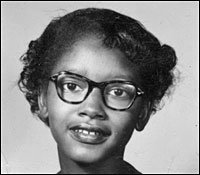Check out five more amazing women whose work has shaped our transportation landscape.
Miss part one? You can go back and read about five more transportation ladies here. You can also check out Part III ladies here.
Frieda Zames, Mathematician and Disability Rights Advocate

Frieda Zames (1932 – 2005) was a lifelong New Yorker who was passionate about math. She worked as a math professor at the New Jersey Institute of Technology for the majority of her career. Zames also needed braces, a wheelchair or a scooter to get around, as she was unable to walk unassisted as a result of contracting polio at just two years old. Beginning in the 1970s, Zames spent her spare time working in the disability rights movement. She lobbied local government, gave lectures and wrote on the topic of disability rights and access. She authored The Disability Rights Movement, From Charity to Confrontation in 2001. Throughout her life, she worked to improve access for individuals with mobility limitations, particularly throughout the city’s transportation landscape. Zames’ work was ultimately integral to the addition of wheelchair ramps to city buses in the 1980s.
http://www.disabledinaction.org/news_zames_nyn.html
image: https://tv.cuny.edu/bio/frieda_zames
Susan Ahn Cuddy, U.S. Navy Officer

Susan Ahn Cuddy (1915 – 2015) was born in California to the first married Korean couple to immigrate to the U.S., just after the turn of the century. Cuddy’s father was staunchly opposed to the Japanese occupation of Korea. He even traveled to Korea to continue his fight against Japan, where he died after being captured by the Japanese and sent to prison in present-day South Korea. When the U.S. entered World War II, Cuddy knew that she wanted to help to fight against the Japanese and carry on her father’s legacy. She decided to enlist in the Navy but was initially rejected as a result of the strong anti-Asian bias at the time. Finally, the Navy allowed her to enlist with the Women Accepted for Volunteer Emergency Services (WAVES), becoming the first Asian-American woman to join the Navy. Cuddy worked her way up the Naval ranks, serving as the first woman gunnery officer, and eventually teaching air combat practices to white men. After five years in the Navy, Chuddy left the military in 1946 and pursued a career in intelligence with the National Security Agency during the Cold War. Just before her death in 2015, the Los Angeles County Board of Supervisors dedicated a day to her to celebrate her life of achievement.
Claudette Colvin, Civil Rights Revolutionary

Claudette Colvin (1939 – present) was a young revolutionary at the forefront of the Civil Rights movement. When she was just a teenager, Colvin refused to give up her seat on the bus to a white woman in Montgomery, AL. Colvin was riding home from school in March of 1955 when she was instructed by the bus driver to give up her seat. She told the bus driver that she would not move, and that it was her constitutional right to do so. Colvin was arrested and brought to jail for her refusal. The NAACP looked at picking up Colvin’s case to fight against segregation on public transportation. However, at the time, the NAACP felt that Colvin would not make a compelling defendant. In the mid-1950s, respectability politics were still very much in control of people’s day-to-day lives, and Colvin did not easily fit the mould. Colvin was met with bias for her dark skin and additional stigma for being a pregnant teenager. Instead, the NAACP decided to recreate the case with Rosa Parks nine months later, who they viewed as a better fit, as Parks was someone who would be able to garner some sympathy from white people in the courtroom as a result of her age and lighter skin. In spite of the NAACP’s decision to use Parks to fight the system instead, Colvin was the catalyst that inspired Parks’ famous story.
https://www.biography.com/activist/claudette-colvin
https://www.npr.org/2009/03/15/101719889/before-rosa-parks-there-was-claudette-colvin
https://scholarworks.gvsu.edu/cgi/viewcontent.cgi?article=1577&context=mcnair
image: https://www.npr.org/2009/03/15/101719889/before-rosa-parks-there-was-claudette-colvin
Alice Huyler Ramsey, Cross-Country Motorist

Alice Huyler Ramsey (1886 – 1983) was a ground-breaking motorist at the turn of the 20th century. The daughter of a coal dealer, Ramsey was interested in engineering and machinery from an early age. In 1908, her husband purchased her a car. Ramsey was so excited about her car that in that first summer she had it, she drove over 6,000 miles around the New Jersey area. That same year, a representative from Maxwell-Briscoe Automobile Company approached Ramsey to see if she would consider being the first woman to drive across the country. Of course, she said yes. In June 1909, Ramsey and three other women left from New York City – Ramsey did all the driving, as she was the only one that knew how. They covered 3,800 miles in 59 days, traveling through Illinois across the west before reaching San Francisco, often following wagon trails to reach their destination. She made more than 30 more cross-country trips in her lifetime, even taking her young children with her for some of them. Ramsey became the first woman to be inducted into the Automotive Hall of Fame in 2000.
https://www.smithsonianmag.com/history/alice-ramseys-historic-cross-country-drive-29114570/
https://specialcollections.vassar.edu/collections/manuscripts/findingaids/ramsey_alice_huyler.html
image: https://www.smithsonianmag.com/history/alice-ramseys-historic-cross-country-drive-29114570/
Mary Riddle, Pilot and Parachutist

Mary Riddle (1902 – 1981) was born in Washington as a member of the Quinault Indian Nation. She was also a member of the Clatsop Tribe in Oregon. Her Quinault name was Kus-de-cha, meaning “Kingfisher.” Riddle felt that her Quinault name – a type of bird – reflected her interest in flying. In the 1920s, Riddle began flying lessons and by 1930, she was able to fly solo, making her the first Native American woman to earn her pilot’s license. By the end of the 1930s, Riddle had begun to practice parachuting, as well. She performed parachute stunts for large groups of people at events that intended to promote aviation. During World War II, she worked as an aircraft inspector.
https://airandspace.si.edu/stories/editorial/native-american-women-aviation-pioneers
Image: https://en.wikipedia.org/wiki/Mary_Riddle#/media/File:MarryRiddle.png


